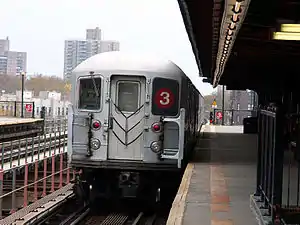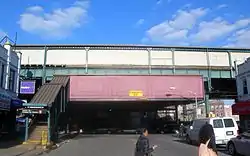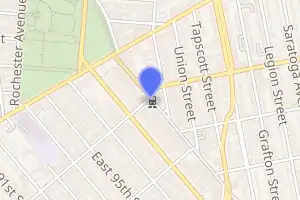Sutter Avenue–Rutland Road station
Sutter Avenue–Rutland Road is a station on the IRT New Lots Line of the New York City Subway, located at the intersection of Sutter Avenue, Rutland Road, and East 98th Street at the border of East Flatbush and Brownsville, Brooklyn. It is served by the 3 train at all times except late nights, when the 4 train takes over service. During rush hours, occasional 2, 4 and 5 trains also stop here.[3]
Sutter Avenue–Rutland Road | ||||||||||||||||||||||||||||||||||||||||||||||||||||||||||||||||||||
|---|---|---|---|---|---|---|---|---|---|---|---|---|---|---|---|---|---|---|---|---|---|---|---|---|---|---|---|---|---|---|---|---|---|---|---|---|---|---|---|---|---|---|---|---|---|---|---|---|---|---|---|---|---|---|---|---|---|---|---|---|---|---|---|---|---|---|---|---|
 An R62 3 train leaving the station, pre-renovation | ||||||||||||||||||||||||||||||||||||||||||||||||||||||||||||||||||||
| Station statistics | ||||||||||||||||||||||||||||||||||||||||||||||||||||||||||||||||||||
| Address | Sutter Avenue / Rutland Road & East 98th Street Brooklyn, NY 11212 | |||||||||||||||||||||||||||||||||||||||||||||||||||||||||||||||||||
| Borough | Brooklyn | |||||||||||||||||||||||||||||||||||||||||||||||||||||||||||||||||||
| Locale | East Flatbush, Brownsville | |||||||||||||||||||||||||||||||||||||||||||||||||||||||||||||||||||
| Coordinates | 40.664884°N 73.922882°W | |||||||||||||||||||||||||||||||||||||||||||||||||||||||||||||||||||
| Division | A (IRT) | |||||||||||||||||||||||||||||||||||||||||||||||||||||||||||||||||||
| Line | IRT New Lots Line | |||||||||||||||||||||||||||||||||||||||||||||||||||||||||||||||||||
| Services | 2 3 4 5 | |||||||||||||||||||||||||||||||||||||||||||||||||||||||||||||||||||
| Transit | ||||||||||||||||||||||||||||||||||||||||||||||||||||||||||||||||||||
| Structure | Elevated | |||||||||||||||||||||||||||||||||||||||||||||||||||||||||||||||||||
| Platforms | 2 side platforms | |||||||||||||||||||||||||||||||||||||||||||||||||||||||||||||||||||
| Tracks | 2 | |||||||||||||||||||||||||||||||||||||||||||||||||||||||||||||||||||
| Other information | ||||||||||||||||||||||||||||||||||||||||||||||||||||||||||||||||||||
| Opened | November 22, 1920 | |||||||||||||||||||||||||||||||||||||||||||||||||||||||||||||||||||
| Rebuilt | October 5, 2016 to June 19, 2017 | |||||||||||||||||||||||||||||||||||||||||||||||||||||||||||||||||||
| Station code | 346[1] | |||||||||||||||||||||||||||||||||||||||||||||||||||||||||||||||||||
| Opposite- direction transfer | Yes | |||||||||||||||||||||||||||||||||||||||||||||||||||||||||||||||||||
| Traffic | ||||||||||||||||||||||||||||||||||||||||||||||||||||||||||||||||||||
| 2019 | 1,047,762[2] | |||||||||||||||||||||||||||||||||||||||||||||||||||||||||||||||||||
| Rank | 353 out of 424[2] | |||||||||||||||||||||||||||||||||||||||||||||||||||||||||||||||||||
| Station succession | ||||||||||||||||||||||||||||||||||||||||||||||||||||||||||||||||||||
| Next north | Crown Heights–Utica Avenue: 2 | |||||||||||||||||||||||||||||||||||||||||||||||||||||||||||||||||||
| Next south | Saratoga Avenue: 2 | |||||||||||||||||||||||||||||||||||||||||||||||||||||||||||||||||||
| ||||||||||||||||||||||||||||||||||||||||||||||||||||||||||||||||||||
| ||||||||||||||||||||||||||||||||||||||||||||||||||||||||||||||||||||
| ||||||||||||||||||||||||||||||||||||||||||||||||||||||||||||||||||||
| ||||||||||||||||||||||||||||||||||||||||||||||||||||||||||||||||||||
History
The New Lots Line was built as a part of Contract 3 of the Dual Contracts between New York City and the Interborough Rapid Transit Company, including this station.[4] It was built as an elevated line because the ground in this area is right above the water table, and as a result the construction of a subway would have been prohibitively expensive.[5] The first portion of the line between Utica Avenue and Junius Street, including this station, opened on November 22, 1920, with shuttle trains operating over this route.[6][7] The line was completed to New Lots Avenue on October 16, 1922,[7] with a two-car train running on the northbound track.[8] On October 31, 1924, through service to New Lots Avenue began.[8]
From October 5, 2016, to June 19, 2017, this station and Junius Street were closed for renovations.[9][10][11]
Station layout
| P Platform level |
Side platform | |
| Northbound | ← ← ← | |
| Center trackway | No track or roadbed | |
| Southbound | | |
| Side platform | ||
| M | Mezzanine | Fare control, station agent, MetroCard machines |
| G | Street level | Exit/entrance |

This elevated station has two side platforms and two tracks with space for a center track that was never added.[12] The middle third of both platforms have beige windscreens and brown canopies supported by green frames and support columns. The remaining two-thirds have black, waist-high steel fences with lampposts at regular intervals. The station signs are in the standard black name plates in white lettering.
This is the northernmost station on the IRT New Lots Line. To the north, the line curves west under Eastern Parkway and goes underground to become the IRT Eastern Parkway Line. The Manhattan-bound track goes underneath the New Lots Avenue-bound track on the south side of the IRT Eastern Parkway Line. A center track begins at a bumper block near the tunnel portal and merges with the two express tracks of the Eastern Parkway line south of Utica Avenue.[12]
Exits
This station has one elevated station house beneath the platforms and tracks. Two staircases from the center of each platform go down to a waiting area/crossunder, where a turnstile bank provides access to/from the station. Outside fare control, there is a token booth and two staircases facing in opposite directions going down to the east side of East 98th Street at the T-intersection of Rutland Road. The north staircase is near the southern corner of the T-intersection of Sutter Avenue and East 98th Street. A third staircase goes down to the northwest corner of East 98th Street and Rutland Road.[13]
References
- "Station Developers' Information". Metropolitan Transportation Authority. Retrieved June 13, 2017.
- "Facts and Figures: Annual Subway Ridership 2014–2019". Metropolitan Transportation Authority. 2020. Retrieved May 26, 2020.
-
- "2 Subway Timetable, Effective September 13, 2020". Metropolitan Transportation Authority. Retrieved December 9, 2020.
- "3 Subway Timetable, Effective September 13, 2020". Metropolitan Transportation Authority. Retrieved December 9, 2020.
- "4 Subway Timetable, Effective September 13, 2020". Metropolitan Transportation Authority. Retrieved December 9, 2020.
- "5 Subway Timetable, Effective September 13, 2020". Metropolitan Transportation Authority. Retrieved December 9, 2020.
- "Nearly 70 Track Miles to Be Added To Rapid Transit Facilities in 1920". Brooklyn Standard Union. December 28, 1919. Retrieved August 14, 2016 – via Fulton History.
- "Differ Over Assessment Plans in Transit Projects: Eastern Parkway Subway and Livonia Avenue Extension the Cause of Bitter Dissension Among Property Owners Uptown". The Daily Standard Union. March 13, 1910. Retrieved August 14, 2016 – via Fulton History.
- "Annual report. 1920-1921". HathiTrust. Interborough Rapid Transit. Retrieved September 5, 2016.
- Cunningham, Joseph; DeHart, Leonard O. (1993). A History of the New York City Subway System. J. Schmidt, R. Giglio, and K. Lang. p. 53.
- "IRT Brooklyn Line Opened 90 Years Ago". New York Division Bulletin. New York Division, Electric Railroaders' Association. 53 (9). September 2010. Retrieved August 31, 2016 – via Issu.
- "ServiceAlert: As of 5 AM, the Sutter Av-Rutland Rd and Junius St stations have reopened for 3 and 4 subway service". @NYCTSubway. June 19, 2017. Retrieved June 19, 2017.
- "Sutter Av-Rutland Rd, Junius St Stations on 3 Line Reopen". www.mta.info. Metropolitan Transportation Authority. June 19, 2017. Retrieved June 19, 2017.
- "The Stations Were Closed for Renewal Work Since April". mta.info. Metropolitan Transportation Authority. September 16, 2016. Retrieved August 28, 2019.
- Dougherty, Peter (2006) [2002]. Tracks of the New York City Subway 2006 (3rd ed.). Dougherty. OCLC 49777633 – via Google Books.
- "MTA Neighborhood Maps: Brownsville" (PDF). mta.info. Metropolitan Transportation Authority. 2015. Retrieved 19 July 2015.
External links
 Media related to Sutter Avenue – Rutland Road (IRT New Lots Line) at Wikimedia Commons
Media related to Sutter Avenue – Rutland Road (IRT New Lots Line) at Wikimedia Commons- nycsubway.org – Brooklyn IRT: Sutter Avenue/Rutland Road
- Station Reporter — 3 Train
- The Subway Nut — Sutter Avenue–Rutland Road Pictures
- Sutter Avenue entrance from Google Maps Street View
- Rutland Road entrance from Google Maps Street View
- Platforms from Google Maps Street View



